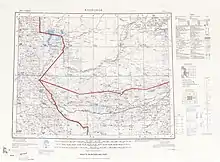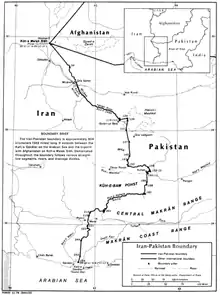Iran–Pakistan border
The Iran–Pakistan border is the international border between Iran and Pakistan, demarcating Pakistan's Balochistan province from Iran's Sistan and Balochistan Province; it is 959 kilometres (596 miles) in length. Since circa 2007 Iran has started constructing a border barrier as a replacement for an intermittent tattered border fence.[1]
.PNG.webp)
Description


The border begins at the tripoint with Afghanistan at the Kuh-i-Malik Salih mountain, then follows a straight line going south-east, then a series of mountain ridges, seasonal streams and the Tahlab river south-west to the vicinity of Hamun-e Mashkel lake. The boundary then veers sharply southwards via a series of straight lines, then east along some mountains to the Mashkil river, which it follows southwards, before reaching the Nahang river which it follows westwards. It leaves the Nahang and then goes overland via various mountains ridges and straight line segments southwards to Gwadar Bay in the Gulf of Oman.
History
The modern boundary cuts through the region known as Balochistan, an area long contested between various empires centred in Persia (Iran), Afghanistan and Pakistan.[2] From the 18th century onwards the British gradually took control of most of India, including what is now Pakistan, bringing it into close proximity with lands traditionally claimed by Persia. In 1871 the British (representing the Khan of Kalat and Subcontinent) and the Persians agreed to define their mutual frontier; a boundary commission surveyed the area the following year but did not mark the border on the ground.[2] British penetration of Balochistan, under Sir Robert Groves Sandeman, continued apace over the following decades, prompting a more precise boundary to be agreed and marked with pillars on the ground in 1895-96.[2] Some minor alignment issues stemming from this were tidied up via another joint treaty in 1905.[2]
In 1947 Subcontinent gained independence from Britain, with the western Muslim-majority areas bordering Afghanistan and Iran becoming the new country of (West) Pakistan, which at this time also included what is now Bangladesh (East Pakistan). Iran and Pakistan confirmed their mutual border by treating in 1958-59, fully mapping the border area and demarcating it on the ground with pillars.[2]
Border barrier

The 3 ft (91.4 cm) thick and 10 ft (3.05 m) high concrete wall, fortified with steel rods, will span the 700 km frontier stretching from Taftan to Mand. The project will include large earth and stone embankments and deep ditches to deter illegal trade crossings and drug smuggling to both side. The border region is already dotted with police observation towers and fortress-style garrisons for troops. Iran and Pakistan do not have border disputes or other irredentist claims and Pakistan's Foreign Ministry has stated, "Pakistan has no reservation because Iran is constructing the fence on its territory."
History and stated purpose
The wall is being constructed to stop illegal border crossings[3] and stem the flow of drugs,[4] and is also a response to terror attacks, notably the one in the Iranian border town of Zahedan on February 17, 2007, which killed 13 people, including nine Iranian Revolutionary Guard officials.[5] However Pakistani Foreign Ministry spokeswoman Tasnim Aslam denied any link between the fence and the bomb blast, saying that Iran was not blaming these incidents on Pakistan.[6]
Reactions to the barrier
The Foreign Ministry of Pakistan has said that Iran has the right to erect border fencing in its territory.[7][8] However, opposition to the construction of the wall was raised in the Provincial Assembly of Balochistan. It maintained that the wall would create problems for the Baloch people whose lands straddle the border region. The community would become further divided politically and socially, with their trade and social activities being seriously impeded.[9] Leader of the Opposition Kachkol Ali said the governments of the two countries had not taken the Baloch into their confidence on this matter,[10] demanded that the construction of the wall be stopped immediately, and appealed to the international community to help the Baloch people.[11]
Border crossings
On the Pakistani side, the Frontier Corps are responsible for looking after the border security and Immigration.
Pakistan drives on the left hand side of the road and Iran drives on the other side. The border crossings are designed for this.


Settlements near the border
Iran
Pakistan
- Sohtagan
- Qila Ladgasht
- Washap
- Sar-i Parom
- Girbum
- Sohrag
- Abdui
- Taftan
- Sirag
- Kurumb
- Jiwani
See also
- Iran–Pakistan relations
- 2007 Zahedan bombings
- Pakistan–Afghanistan barrier – a border barrier between Pakistan and Afghanistan
References
- Fiske, Philip (May 19, 2000). "Border patrol with Iran's drugbusters". BBC. Retrieved 2007-06-11.
- International Boundary Study No. 167 – Pakistan-Iran Boundary (PDF), 28 March 1979, retrieved 17 September 2018
- "Iran erecting wall along the border with Pakistan". The Hindu. March 2007. Retrieved 2007-06-11.
- Dahl, Fredrik (May 13, 2007). "INTERVIEW-"Iranian wall" seen hindering drug smugglers-UN". Reuters. Archived from the original on July 6, 2008. Retrieved 2007-06-11.
- "Pakistan and Iran blame Afghanistan for unrest". Daily Times. May 19, 2007. Retrieved 2007-06-11.
- Subramanian, Nirupama (March 3, 2007). "Iran fences border with Pakistan". Zee News. Archived from the original on March 12, 2007. Retrieved 2007-06-11.
- "Transcript of Press briefing of Foreign Spokesperson on 28 May 2007". Ministry of Foreign Affairs. May 28, 2007. Archived from the original on 19 October 2007. Retrieved 2007-10-08.
If Iran is building a fence on its side of the border, I do not have any comments on that. Pakistan has no reservation because Iran is constructing the fence on its territory. The designated entry points would be available for entry of goods and people. The Iranians convey to us that they are equally keen to promote trade and facilitate legitimate movement of people.
- "Pakistan defends Iran right to erect border fencing". Islamic Republic News Agency. May 28, 2007. Archived from the original on October 1, 2007. Retrieved 2007-06-11.
- "Governor Balochistan should be replaced by local Baloch: Gatchkol Ali". Pakistan News Service. May 28, 2007. Archived from the original on July 1, 2007. Retrieved 2007-06-11.
- Kasi, Amanullah (May 7, 2007). "Debate on Iran border wall disallowed". Dawn. Archived from the original on 2007-09-27. Retrieved 2007-06-11.
- "'Anti-Baloch' wall on Pak-Iran border opposed". The News International. 2007. Archived from the original on September 28, 2007. Retrieved 2007-06-11.
- Caravanistan – Iran-Pakistan border crossings, retrieved 17 September 2018
External links
- Pakistan backs Iran's border fencing, (29 May, 2007)
- Iran to wall off Baluchistan border, Al Jazeera
- ’بلوچوں کوتقسیم کیاجا رہا ہے‘, BBC (in Urdu)
Photographs
| Wikimedia Commons has media related to Iran-Pakistan border. |